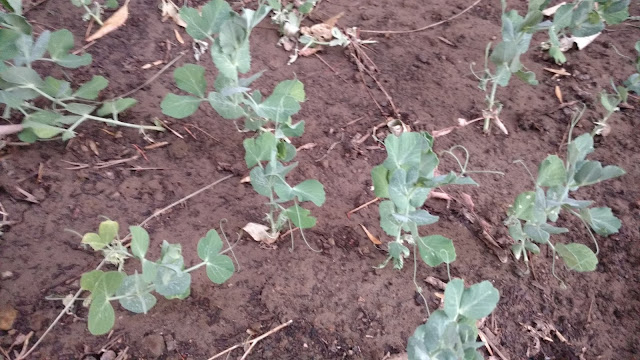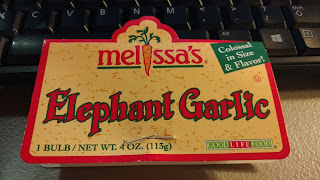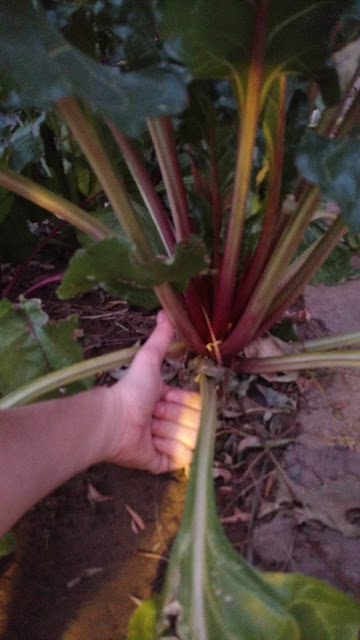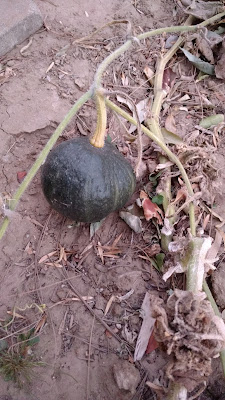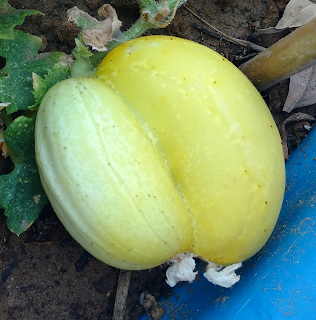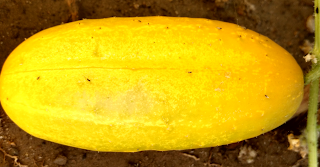 |
| Wishing you a Merry 77 & Sunny, and a Happy 76 w/ Clouds! |
Ditto for November.
Which leads me to the real topic of this post -- Because although our weather has been lovely... I haven't been here to enjoy it. Much to my shame, my garden rap sheet now includes abandoning my vegetables for the last 5 weeks.
The person who was going to water/check on it had to back out last minute. So my poor garden has spent the last 40 days enduring the following all on its lonesome:
- zero rain/irrigation
- warm temps
- 25-45mph Santa Ana winds
- ash from the huge Thomas fire, and two smaller nearby fires
Cut to: MY ARRIVAL HOME!
Stumbling around the garden in the dark, fully expecting to be arrested by mother nature for criminal garden abuse, tripping over fallen branches fatter than my arm, camera flashlight my only guide, desperately seeking out any signs of life...
Truthfully, I was expecting to find nothing more than what I found this spring when I moved in -- an empty sandlot pocked with a few scattered weeds, poking up their plump seed heads like middle fingers, crows guffawing at my stupidity from the trees. She's going grow stuff, here? Ha! Hey Lou, check out this joker...
(Truthfully, when I moved in last March it was actually a not-quite-so-empty sandlot... unfortunately.)
However, an empty sandlot is not what I found that night.
And... well, I'm still confused about it.
BEHOLD! The stubbornness of life.
So, without further ado, may I introduce you to my new friend, dry farmed.... lettuce?
 | ||
| I know, I should have flipped the photo. But this post has so many pics... I got lazy. |
Seeing as peppers are planted nearby, I assure you this is not a shady part of my garden. I planted the lettuce here with the intent of putting up a shade cloth before leaving (and having someone here to water it, clearly) but in my rush I completely forgot to cover it.
So... not only did the lettuce survive in +/-10 hours of daily sunlight and warm-to-hot temps, but it did so in sandy soil with no rain/irrigation for over a month. But... doesn't lettuce have shallow roots? Need constant moisture? Hate high temps? I'm confused.
But wait, there's more --
Here's the second bed, in a far SHADIER part of the garden and with NO competition from pepper roots for what little moisture there was.
It did worse than the other bed. >?? Both were seeded from the same seed packet at the same planting density on the same day and watered the same amount (then abandoned the same amount.)
This makes no sense.
And that's just the lettuce.
As for carrots...
 |
| Sorry for the crappy photo, I was losing light and moving fast. |
Also seeded right before I left. Also... sprouted?
Now, the picture below was taken the day before I left. Carrots were seeded that same day on the bottom of the right bed, below the flags (which don't mean anything, they were re-used). Above them, elephant garlic seeded a few days previous. In the left bed, onions (no survivors - at least one thing I expected!)
Everything was deeply watered that day, then abandoned, blah blah, you know the drill.
Fast forward 5 weeks of summer weather and no water, yadda yadda, and here we have:
Carrots?
Ok... so I don't know about you, but everything I've ever read about carrots says they take 3 weeks to germinate and must be kept evenly moist. Meanwhile, these guys are living in dirt dryer than my sense of humor.
While germination was clearly spotty, the fact that there was germination at all truly perplexes me. The carrots were a mix of several varieties sown together, and now I really wish I'd differentiated. Was it a single variety that did well? Or did one side of the bed just have a magical water gnome kingdom nestled below it?
Dry lettuce? Dry carrots? What is going on here?
On the other side of the spectrum --
Brassica bed before I left:
Annnnnd.....after.
 |
| the glory |
...fine, don't like kale anyway.
Onto the legumes, which I figured would survive, if anything would. Boy, was that a mixed bag. As far as the fava beans went, the young sprouts survived the drought and heat much better than my more established plants (huh?) even though they did grow very slow.
Even then, the level of 'success and survival' I'm talking about here is pretty helter-skelter.
On the left, Ianto's Yellow and Extra Precoce a Grano Violetto were barely sprouted when I left, and seem to have done ok. On the right, Robin Hood and Windsor were about six inches tall when I left, and were mostly destroyed.
All peas, on the other hand, were as cheerful as ever, even for being 1/4 their normal size. All varieties were seeds in the ground when I left. I did have a few dead sprouts here and there, but those that lived show no damage from heat/water deprivation.
I gotta say, I love peas... both to eat and for their endearing, childish nature. They always look like they're reaching for you to pick them up. And they're nosy, touching everything. What's this... i grab this? mine... what's that? --
One of my other Cascadia plots has even given me flowers!
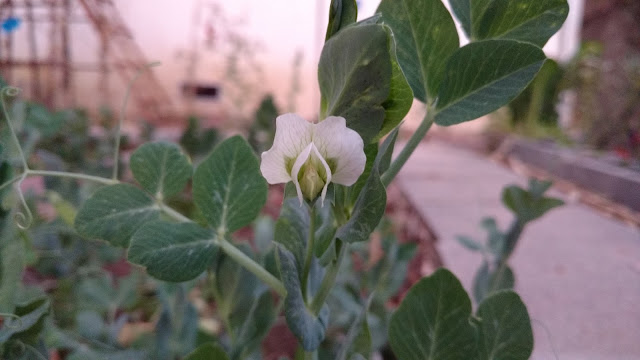 |
| I want to draw eyes on it so bad you don't understand |
And this overachiever even gave me one whole pea, huzzah.
OH. Another big surprise... elephant garlic! I feel like a proud mother, and I didn't even do anything. The cloves were hardly two days in the ground when I left (remember the carrot picture?)
But boy oh boy, look at my babies now...
 |
| another crappy, losing the light pic |
100% germination. And, yes, turns out even the slacker in the bottom left was present and accounted for, albeit tiny and drowning under tree crap.
And you know what's even MORE interesting? All these elephant garlic sprouts came from grocery store! (except the three closest to the flags) Yep, plain old elephant garlic, $3 a head (I think?) with tons of huge cloves per head. And those three topmost cloves? Um, the entire contents of a $4 bag at Green Thumb.
I know, right. Garden hack win.
Here's the grocery brand. Definitely no sprout inhibitors in these. Hard to tell from the picture, but all grocery store clove plants (excluding poor drowned bob) are taller than the three from Green Thumb.
Oh, and I almost forgot.
Remember when I posted about growing eggplant for the first time and being really 'blah' about eating it and all the plants being covered in spider mites and finally just saying fuck it and ripping them all out?
yeaaah, about that...
Meet the Moriarty, the un-killable eggplant.
 |
| You should see him in a crown. |
Was.
Clearly, I got attached.
But I mean -- its recovery was astounding. It went from a dumb stick to a fully leafed dandy producing flowers like crazy, all in a few weeks. Three plump, grapefruit sized fruit in it's first reborn flush, no problem.
Right before I left, it was working on ripening this masterpiece:
And when I got back:
A bit dirtier, no bigger, but ultimately no worse for the wear. If this little dingle-berry has seeds, I'm saving them.
I mean, look at it! It's like a perfect little purple... anatomy. I love it.
A few more before and afters:
(excuse the constant switching between photo angles; I don't think that far ahead when I take them)BEETS - before
... and after.
They don't look much bigger in the picture, but I assure you they got huuuge while I was gone.
Here's another shot of the beets, but instead of the beets, take note of the volunteer mystery tomato on the right.
That thing... is the slowest growing, least needy tomato I have ever encountered. It's like a stoner tomato. It showed up, maybe, five months ago? Hardly grows, lives happily with only 3 to 4 hours morning sun. In fact, it had its biggest growth spurt this past month while I was gone, and had zero crispy/dead leaves after five weeks no water.
It was even putting out it's first flower the day I got back.
Who are you...
 |
| so dark, so fast |
In other volunteer tomato news --
I dunno who this dude is either, or how he got all the way back into my pea/bean patch, but hey, keep on keeping on little slugger. I wanna taste those green ones on the bottom once they ripen up.
Unfortunately I was overeager... those red ones were, um, severely overripe.... *retches quietly in the background*
As for my intentionally planted tomatoes...I'll just let the 'after' pictures speak for themselves:
If you know anyone in need of a few spiders mites, I might have a couple I could spare...
And, go figure, the Ajvarski Peppers that I've been talking smack about ALL summer because of their blossom end rot issues (due to inconsistent watering, I thought) decided to be cheeky and produce some of the most flawless, huge, tasty, non-butt-rotted fruits ever... after being consistently not-watered for more than a month.
Regardless, I won't complain about having a ripe, sweet peppers a few days before new years.
In cucumber news, this hastily constructed trellis made from early season Sunflower stalks was home to a few Suyo Long plants I was trying out (and one dead pickling type, rip). The plants were already succumbing to powdery mildew when I left.
... and now it just looks like the cucumber monster took a shit in my planter.
This Tetsukabuto squash plant was also dying from powdery mildew when I left. It was a late season start, kindly made possible by Dave @ Our Happy Acres who sent me the seed. Thanks Dave! This poor plant was over crowded and poorly treated from the start, seeing as it was my test subject and not part of my original garden plan. In turn, it produced only one fruit, which was still growing when I left.
After I returned:
Not too shabby, all things considered. I look forward to growing more of these in much better conditions this coming season.
I'll finish with a personal squash project picture -- this is my nicknamed 'Bourbon' F1 (Buttercup x Turban) that colored up nicely while I was gone. I was an 'out of curiosity' cross made early last year, so I was able to grow out the offspring later the same season. This spring I'll plant seeds from this baby, mostly to enjoy watching how the different colors/shapes/sizes segregate in the F2. I probably won't continue the project beyond there, unless something unusual, tasty, or interesting pops up.
In conclusion - what a strange, fascinating homecoming!
I need a beer.







